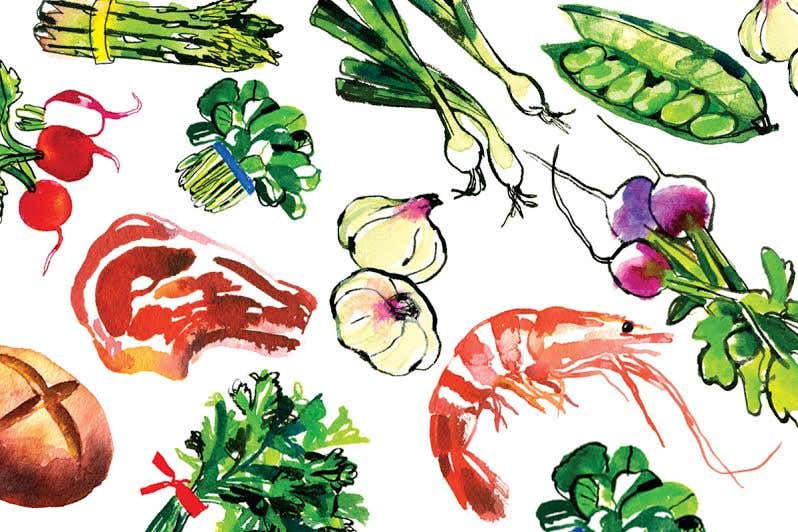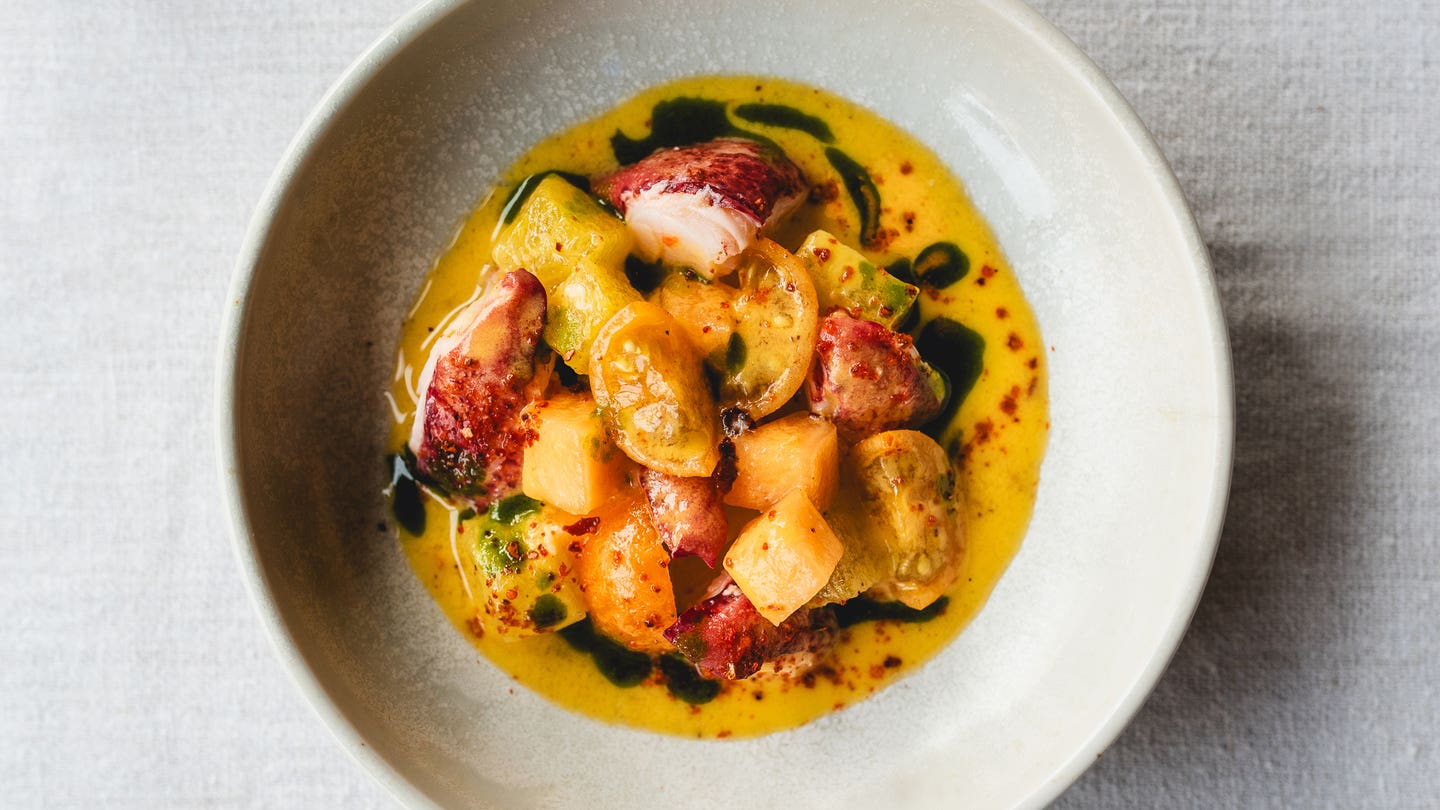
Everybody’s Ginger
Both hot and cool, this delightfully pungent spice is used and loved in kitchens all over the world.
Every Saturday morning when we were children, my brother Charlie and I seemed to end up lying flat on our stomachs on the carpeted aisle of the Iao Theatre in Wailuku, on the island of Maui, gazing up at serial reruns of Hopalong Cassidy and Perils of Nyoka. And as we watched, our hands would inevitably reach, over and over again, into small cellophane packages of Chinese preserved ginger—red slivers of salty-sweet "seeds" (we called all Chinese preserves seeds, whether they had any or not). By the movies' end, our tongues, thumbs, and index fingers were stained bright pink and our mouths were burning from the heat the ginger generated. It is one of my most vivid childhood memories.
At home, my father—I always think of him now as Tutu-man, the name his grandchildren gave him years later—considered fresh ginger an essential, keeping knobby "hands" of it in the cool of our larder, alongside the sweet Maui onions, garlic, and potatoes. He broke off pieces as he needed them, peeled them, sliced them into dime-size rounds, and then mashed them with the handle of his knife until they split into fibers and the juice ran out onto the chopping block, filling the kitchen with its clean, sharp aroma.
Fresh ginger went into everything he cooked—from the island-style teriyaki sauce in which he marinated chicken and thinly sliced beef, to the clear soups he made with abalone and wong bok cabbage. That was back in the 1950s, and we were definitely ahead of our time in Hawaii. Elsewhere in the United States, outside of the Chinatowns in larger cities, fresh ginger was all but unknown.
Today, fresh ginger is available everywhere in America. In fact, in either its dried or its fresh form, ginger has found its way, over the centuries, into almost every cuisine on earth. It might show up in a German cookie, a Moroccan tagine, a Chinese fish dish, an Italian pasta—even a marmalade from Australia. It's used in traditional societies worldwide as a medicine to cure nausea and to aid digestion, and is said to improve circulation and ease vertigo and menstrual distress.
The cultivation of edible ginger—the gnarled, papery-skinned rhizome of the tropical herb Zingiber officinale—is so ancient in Asia that its origins cannot be traced. Still, food scholar and cook Bruce Cost accounts for at least the last 21 centuries in his Ginger East to West (Addison-Wesley, 1984). Ginger was already a crucial ingredient, he says, when the Chinese cooking we know today evolved in the Chou period (1200 to 221 B.C.). Revered as a symbol of purity, ginger was a staple of the Confucian diet, even during fasts, and was tacked to the doorway when a baby was born to ward off any evil that might slip in. The Chinese consider ginger a yang, or hot, food, which balances the cooling yin foods to create harmony. A woman in a very yin state after giving birth, for instance, might be given a bowl of hot pig's-feet soup liberally laced with ginger to restore a yang element to her system.
Ginger traveled to Europe, most often in dried form, along the Middle Eastern trade routes. Introduced to England before the Norman Conquest in 1066, the spice became so popular that, by the 14th century, it sat beside the salt and pepper on most tables, to be sprinkled on meats and other savory dishes. Ginger even came to color everyday speech: a redhead's locks are "ginger", and a "gingery" morning is invigorating. By the Elizabethan period, the English were also gingering up their sturdy beers and ales. This custom was further elaborated in the Caribbean colonies, where cooks fermented fresh ginger in lime and rum. (Alcoholic ginger ale's tame descendant, the commercial mixer we know today, is made with ginger extract, carbonated water, sugar, and other flavorings.)
Planted in Jamaica and the West Indies soon after the arrival of Columbus, ginger grew into a profitable crop for Spain. Portugal, meanwhile, began raising it commercially in Brazil and Sierra Leone. Before long, the slaves who tended the fields in these places began combining fresh ginger with African and New World ingredients in their own cooking. Though fresh ginger became essential to Caribbean and South American cuisine, enthusiasm for dried ginger waned in Western Europe after the 17th century. The use of spices in general declined as it became fashionable to serve meats fresh rather than aged, and ginger's racy reputation for "heating the blood" was increasingly frowned upon with the rise of Puritanism.
Aside from the occasional cookie or spice cake, it wasn't until the 1970s that mainstream Western cooks rediscovered ginger—and when they did, it was the fresh variety. This taste for ginger was spurred in part by the arrival of immigrants from Southeast Asia folllowing the Vietnam War; the market for exotic fresh ingredients was further stimulated s food and travel writers spurred interest in international cuisines. Demand for fresh ginger has risen ever since: Americans now consume upwards of 35 million pounds of it a year, mostly grown in Hawaii, Indonesia, Fiji, Thailand, Brazil, Costa Rica, Ecuador, and China.
It wasn't until I was an adult that I connected the glossy hands of ginger piled high in market bins on Maui with the loamy, green fields that dot the Big Island's Hamakua Coast north of Hilo. In good years, this region supplies about one-third of the ginger Americans consume, with the most successful farming still done by families on plots smaller than five acres. Carefully tended, even mom-and-pop farms as small as a quarter-acre can prosper.
Standing in the cool, damp fields of one small ginger farm, I finger the slender leaves that brush my waist and think about the plump, beige rhizomes working their way to the surface beneath my feet. And I wonder if my brother Charlie still sneaks into a "seed shop" near his Honolulu condominium these days for a little bag of slivered red ginger to eat while he watches the late, late show on television.
Keep Reading
Continue to Next Story










